p21 Restricts HIV-1 in Monocyte-Derived Dendritic Cells through the Reduction of Deoxynucleoside Triphosphate Biosynthesis and Regulation of SAMHD1 Antiviral Activity
- PMID: 28931685
- PMCID: PMC5686764
- DOI: 10.1128/JVI.01324-17
p21 Restricts HIV-1 in Monocyte-Derived Dendritic Cells through the Reduction of Deoxynucleoside Triphosphate Biosynthesis and Regulation of SAMHD1 Antiviral Activity
Abstract
HIV-1 infection of noncycling cells, such as dendritic cells (DCs), is impaired due to limited availability of deoxynucleoside triphosphates (dNTPs), which are needed for HIV-1 reverse transcription. The levels of dNTPs are tightly regulated during the cell cycle and depend on the balance between dNTP biosynthesis and degradation. SAMHD1 potently blocks HIV-1 replication in DCs, although the underlying mechanism is still unclear. SAMHD1 has been reported to be able to degrade dNTPs and viral nucleic acids, which may both hamper HIV-1 reverse transcription. The relative contribution of these activities may differ in cycling and noncycling cells. Here, we show that inhibition of HIV-1 replication in monocyte-derived DCs (MDDCs) is associated with an increased expression of p21cip1/waf, a cell cycle regulator that is involved in the differentiation and maturation of DCs. Induction of p21 in MDDCs decreases the pool of dNTPs and increases the antiviral active isoform of SAMHD1. Although both processes are complementary in inhibiting HIV-1 replication, the antiviral activity of SAMHD1 in our primary cell model appears to be, at least partially, independent of its dNTPase activity. The reduction in the pool of dNTPs in MDDCs appears rather mostly due to a p21-mediated suppression of several enzymes involved in dNTP synthesis (i.e., RNR2, TYMS, and TK-1). These results are important to better understand the interplay between HIV-1 and DCs and may inform the design of new therapeutic approaches to decrease viral dissemination and improve immune responses against HIV-1.IMPORTANCE DCs play a key role in the induction of immune responses against HIV. However, HIV has evolved ways to exploit these cells, facilitating immune evasion and virus dissemination. We have found that the expression of p21, a cyclin-dependent kinase inhibitor involved in cell cycle regulation and monocyte differentiation and maturation, potentially can contribute to the inhibition of HIV-1 replication in monocyte-derived DCs through multiple mechanisms. p21 decreased the size of the intracellular dNTP pool. In parallel, p21 prevented SAMHD1 phosphorylation and promoted SAMHD1 dNTPase-independent antiviral activity. Thus, induction of p21 resulted in conditions that allowed the effective inhibition of HIV-1 replication through complementary mechanisms. Overall, p21 appears to be a key regulator of HIV infection in myeloid cells.
Keywords: HIV replication; HIV-1; SAMHD1; cellular factors; dNTPs; dendritic cells; p21.
Copyright © 2017 American Society for Microbiology.
Figures
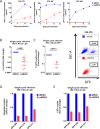

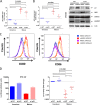

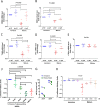
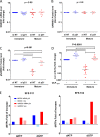
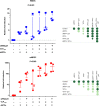

Similar articles
-
USP18 (UBP43) Abrogates p21-Mediated Inhibition of HIV-1.J Virol. 2018 Sep 26;92(20):e00592-18. doi: 10.1128/JVI.00592-18. Print 2018 Oct 15. J Virol. 2018. PMID: 30068654 Free PMC article.
-
SAMHD1 restricts HIV-1 infection in dendritic cells (DCs) by dNTP depletion, but its expression in DCs and primary CD4+ T-lymphocytes cannot be upregulated by interferons.Retrovirology. 2012 Dec 11;9:105. doi: 10.1186/1742-4690-9-105. Retrovirology. 2012. PMID: 23231760 Free PMC article.
-
p21-mediated RNR2 repression restricts HIV-1 replication in macrophages by inhibiting dNTP biosynthesis pathway.Proc Natl Acad Sci U S A. 2013 Oct 15;110(42):E3997-4006. doi: 10.1073/pnas.1306719110. Epub 2013 Sep 30. Proc Natl Acad Sci U S A. 2013. PMID: 24082141 Free PMC article. Clinical Trial.
-
Roles of SAMHD1 in antiviral defense, autoimmunity and cancer.Rev Med Virol. 2017 Jul;27(4). doi: 10.1002/rmv.1931. Epub 2017 Apr 25. Rev Med Virol. 2017. PMID: 28444859 Review.
-
The missing link: allostery and catalysis in the anti-viral protein SAMHD1.Biochem Soc Trans. 2019 Aug 30;47(4):1013-1027. doi: 10.1042/BST20180348. Epub 2019 Jul 11. Biochem Soc Trans. 2019. PMID: 31296733 Free PMC article. Review.
Cited by
-
USP18 (UBP43) Abrogates p21-Mediated Inhibition of HIV-1.J Virol. 2018 Sep 26;92(20):e00592-18. doi: 10.1128/JVI.00592-18. Print 2018 Oct 15. J Virol. 2018. PMID: 30068654 Free PMC article.
-
HIV-1 controllers exhibit an enhanced antiretroviral innate state characterised by overexpression of p21 and MCPIP1 and silencing of ERVK-6 RNA expression.Mem Inst Oswaldo Cruz. 2024 Sep 16;119:e240071. doi: 10.1590/0074-02760240071. eCollection 2024. Mem Inst Oswaldo Cruz. 2024. PMID: 39292108 Free PMC article.
-
Immunometabolism and HIV-1 pathogenesis: food for thought.Nat Rev Immunol. 2021 Jan;21(1):5-19. doi: 10.1038/s41577-020-0381-7. Epub 2020 Aug 6. Nat Rev Immunol. 2021. PMID: 32764670 Review.
-
SAMHD1: Recurring roles in cell cycle, viral restriction, cancer, and innate immunity.Autoimmunity. 2018 May;51(3):96-110. doi: 10.1080/08916934.2018.1454912. Epub 2018 Mar 27. Autoimmunity. 2018. PMID: 29583030 Free PMC article. Review.
-
Increased expression of CDKN1A/p21 in HIV-1 controllers is correlated with upregulation of ZC3H12A/MCPIP1.Retrovirology. 2020 Jul 2;17(1):18. doi: 10.1186/s12977-020-00522-4. Retrovirology. 2020. PMID: 32615986 Free PMC article.
References
-
- Burleigh L, Lozach PY, Schiffer C, Staropoli I, Pezo V, Porrot F, Canque B, Virelizier JL, Arenzana-Seisdedos F, Amara A. 2006. Infection of dendritic cells (DCs), not DC-SIGN-mediated internalization of human immunodeficiency virus, is required for long-term transfer of virus to T cells. J Virol 80:2949–2957. doi:10.1128/JVI.80.6.2949-2957.2006. - DOI - PMC - PubMed
-
- Nobile C, Petit C, Moris A, Skrabal K, Abastado JP, Mammano F, Schwartz O. 2005. Covert human immunodeficiency virus replication in dendritic cells and in DC-SIGN-expressing cells promotes long-term transmission to lymphocytes. J Virol 79:5386–5399. doi:10.1128/JVI.79.9.5386-5399.2005. - DOI - PMC - PubMed
Publication types
MeSH terms
Substances
Grants and funding
LinkOut - more resources
Full Text Sources
Other Literature Sources
Miscellaneous

